Artificial Intelligence in Robotics Market Size
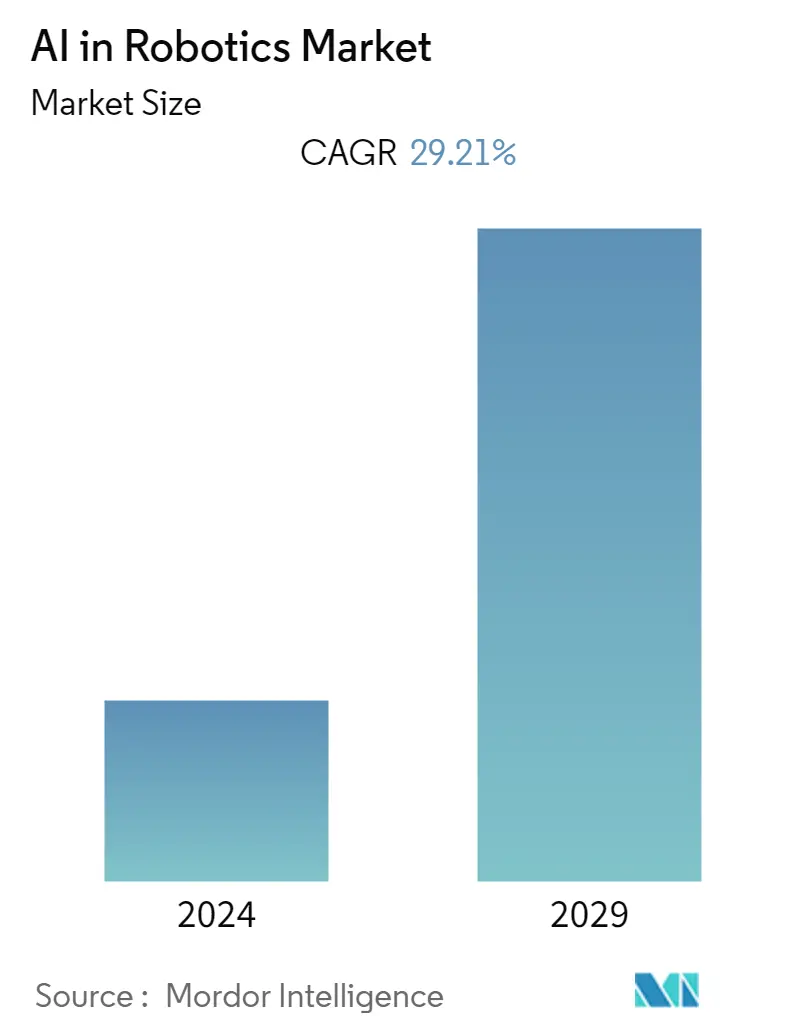
| Study Period | 2021 - 2029 |
| Base Year For Estimation | 2023 |
| CAGR | 29.21 % |
| Fastest Growing Market | Asia-Pacific |
| Largest Market | Asia-Pacific |
| Market Concentration | Medium |
Major Players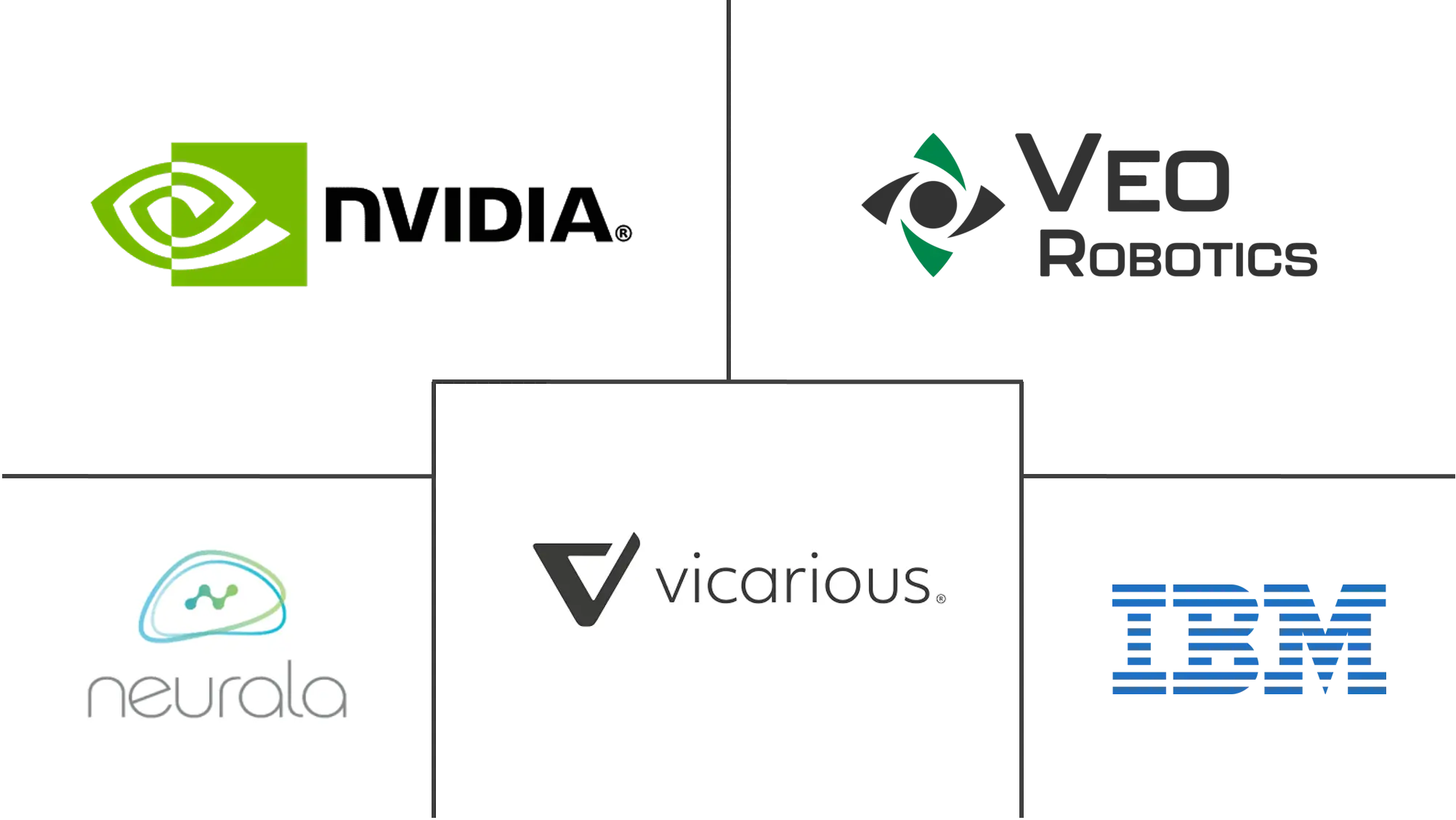
*Disclaimer: Major Players sorted in no particular order |
Artificial Intelligence in Robotics Market Analysis
Artificial Intelligence in the robotics market is expected to register a CAGR of 29.21% during the forecast period. Artificial intelligence (AI) and robotics prove to be a powerful combination for automating tasks and processes. AI in robotics gives flexibility in operations and enables robots with learning capabilities in various applications. Artificial intelligence in robots offers companies new opportunities to increase productivity, make work safer, and save people valuable time.
- Integration of robotics and AI augments and amplifies human potential, increases productivity, and moves from simple reasoning to human-like cognitive abilities. The next stage of artificial intelligence is the era of "augmented intelligence," which seamlessly links humans and machines together.
- Robots are designed to perform repetitive tasks with utmost precision and increased speed. AI in robotics helps the robots learn the processes and perform the functions with complete autonomy, without any human intervention. These benefits are expected to augment market growth.
- Also, higher adoption rates of robots in almost all the end-user verticals, coupled with support from governments worldwide to develop modern technologies, are undoubtedly significant factors augmenting the market's growth. However, a reluctance to adopt technological developments is expected to slow market growth. Also, a lack of a skilled workforce to adopt the integration of AI in robotics is hindering market growth.
- However, the lack of experts with the necessary knowledge and expertise to operate AI robots will prevent their widespread adoption across various industries. In addition, the absence of appropriate regulations in this industry would reduce its demand globally. Companies in sectors with the lowest labor costs are gradually implementing AI robots.
Due to rising automation technology demand as well as the growing use of AI robots in the medical sector to control COVID-19, the market for artificial intelligence (AI) robots has grown dramatically in recent years. Due to its ability to handle the complexity of massive data and provide high accuracy and quick processing solutions, artificial intelligence (AI) is being used to advance science and technology. Due to the increased demand for automation in the manufacturing, automotive, and industrial sectors in the post-COVID-19 period, businesses are assessing the long-term income potential of AI robots.
Artificial Intelligence in Robotics Market Trends
This section covers the major market trends shaping the Artificial Intelligence in Robotics Market according to our research experts:
Industrial Robots Expected to Grow Significantly
- Major technological disruptions, like artificial intelligence and machine learning, are making their way to the industrial robotics industry. Industrial robots are used in factories to do dangerous, repetitive, boring, and/or automated tasks that need to be done quickly and accurately.
- The merging of AI and industrial robotics is providing several benefits to its early adopters. One of the greatest benefits is increased uptime and productivity from predictive maintenance. With AI integrated with industrial robotics technology, robots can monitor their accuracy and performance, signaling when maintenance is required to avoid expensive downtime.
- Furthermore, AI-based industrial robots make fault detection and resolution easier.They are programmed to detect the defects and fed with solutions to overcome the damage.
- Also, industrial robots improve production speed, accuracy, and safety. Robots also enable organizations to adopt modern manufacturing techniques and build a robust manufacturing industry. AI technology can give robots the power to see, identify, and interact with what they see.
Global shipments of industrial robots totaled about 384,000 in 2020, a little up from 2019. Industrial robot shipments are anticipated to rise sharply in the years to come, possibly even exceeding the peak year of 2018, when some 422,000 industrial robots were shipped globally. Global shipments of industrial robots are predicted to reach 518,000 units in 2024.
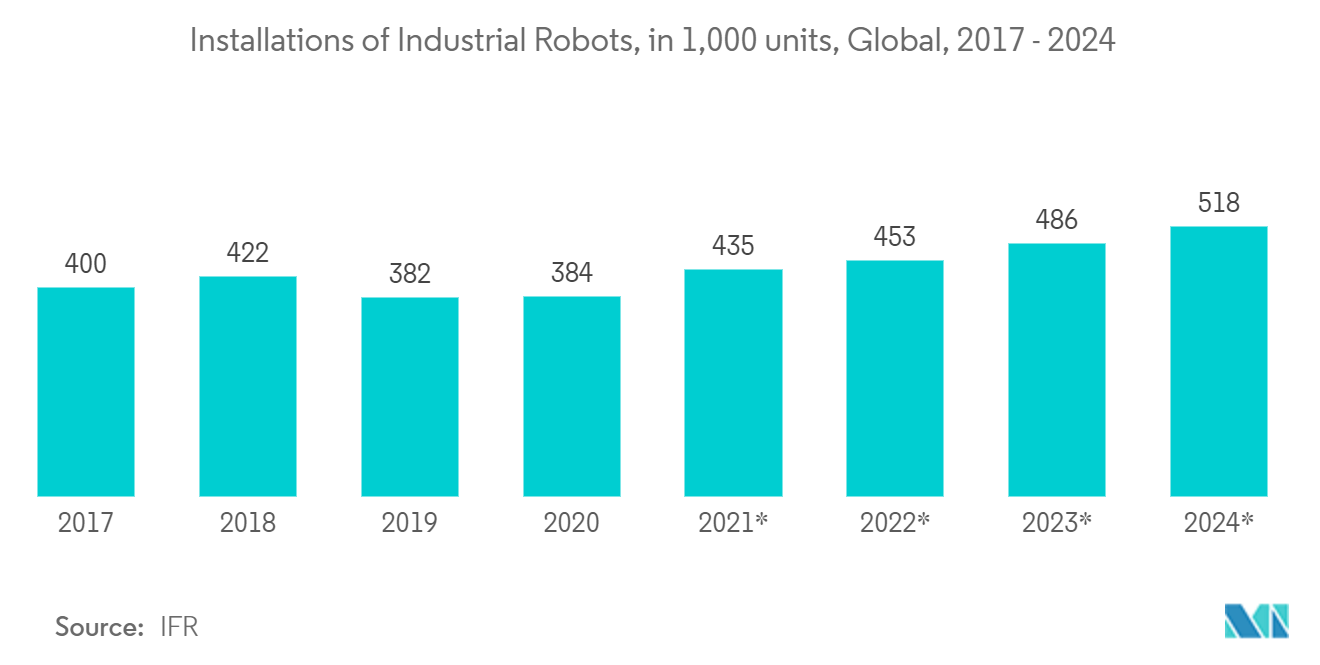
North America is Expected to Grow Significantly
- The North American region is one of the prominent innovators and pioneers in the adoption of robotics and is one of the largest markets. The factors driving the market growth include the increase in warehouse automation, rising adoption of automated material handling and trends, like lights-out automation, and increasing adoption of these robots across numerous industries.
- Robots in the coming future, with the help of technology, will be able to perceive their nearby environments through every connected sensor in real-time, learn naturally from surroundings and use natural language processing, and maintain their hardware by predicting failures that other robots will fix. These trends in the market are expected to drive the demand for robots during the forecast period.
- The automotive, food and beverage, and pharmaceutical sectors are the region's largest sources of demand for industrial robots. Industrial robots are extensively being deployed in food and beverage manufacturing establishments. Furthermore, the stringent food safety regulations and preference for low human intervention in the production process are expected to increase the demand for the food and beverage industry over the forecast period.
- The major driver for the growth of robots in the region is that all the manufacturing industries in the U.S. are currently under the ongoing trend to automate their production process to strengthen the U.S. industries in both domestic and international markets.
- Although numerous A.I. efforts have surfaced at the state and federal levels, the United States still needs to pass comprehensive A.I. legislation. More federally proposed measures were introduced from 2 in 2012 to 131 last year, including A.I. provisions. Even though the number of legislation presented has dramatically increased, only 2% of those proposals are finally passed into law by the U.S. Congress. But with a foundation law, businesses can use A.I. technologies per the rules and regulations established by the government, making it more straightforward for them to adopt the technology. Thus, this is anticipated to drive the market in the upcoming years.
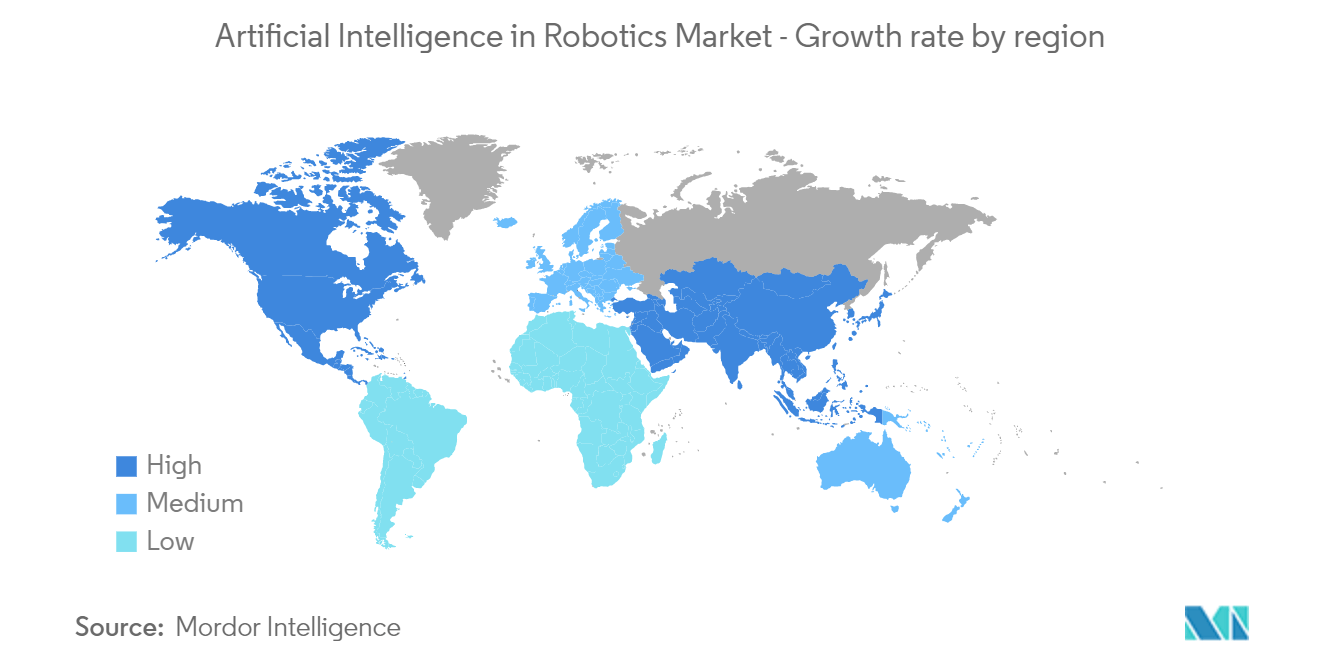
Artificial Intelligence in Robotics Industry Overview
The competitive landscape of artificial intelligence in robotics is moving towards fragmentation as the market is growing and providing ample opportunities to robot vendors. The vendors are ready to seize the first-mover advantage and seize the opportunities presented by various technologies.Also, the vendors view product innovation and global expansion as paths toward gaining maximum market share.
In August 2022, to establish an artificial intelligence research facility in the United States, Boston Dynamics and Hyundai Motor Group committed USD 424 million. The Boston Dynamics AI Institute will be situated in Cambridge, Massachusetts. Its primary objective will be to offer advancements in robotics and artificial intelligence (AI), which the business considers growth-oriented fields. The Institute is anticipated to work on resolving the most significant and challenging issues regarding the development of advanced robotics.
Artificial Intelligence in Robotics Market Leaders
-
Vicarious AI
-
Neurala, Inc.
-
Veo Robotics, Inc.
-
NVIDIA Corporation
-
IBM Corporation
*Disclaimer: Major Players sorted in no particular order
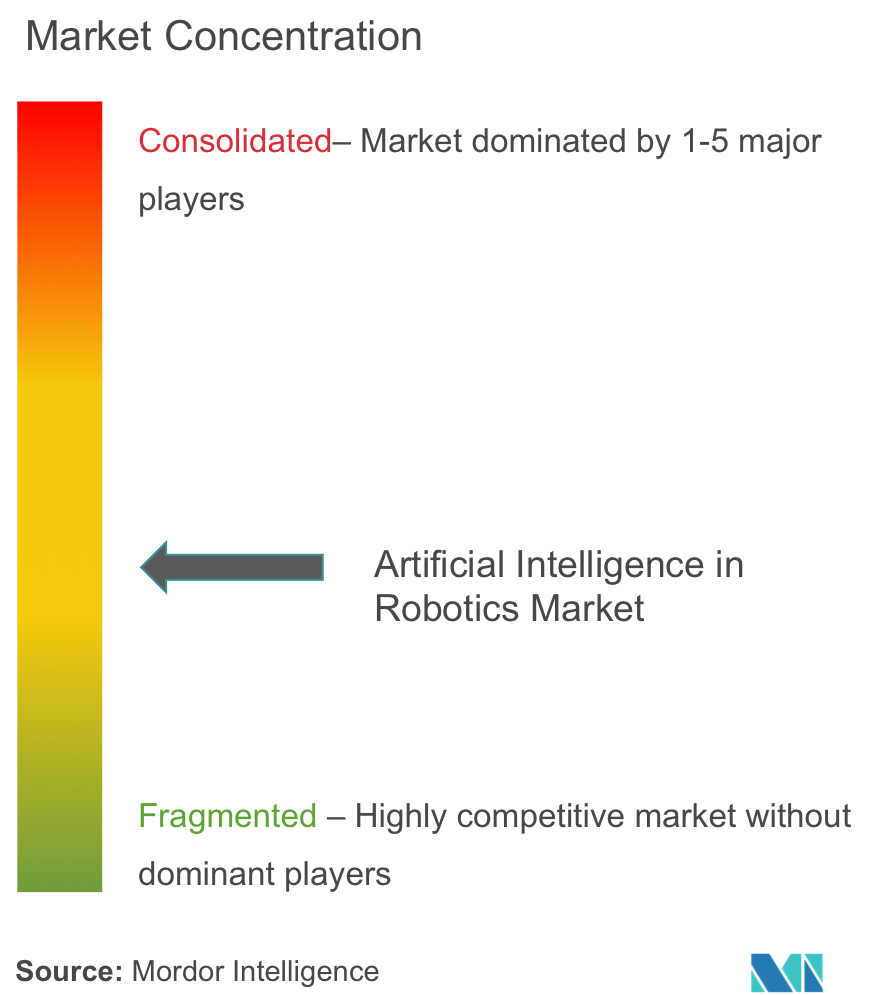
Artificial Intelligence in Robotics Market News
- July 2022: In order to develop robotics-as-a-service (RaaS) solutions and artificial intelligence (AI) cloud platforms globally, Guardforce AI Co., Limited, a provider of integrated security solutions, has announced a collaboration agreement with Hong Kong Industrial Artificial Intelligence and Robotics Centre Limited (FLAIR), founded by the Hong Kong Productivity Council (HKPC) with RWTH Aachen Campus in Germany as its major collaborator. In accordance with the agreement, Guardforce AI will have initial, two-year access to FLAIR technology and know-how beginning in August 2022.
- November 2022: The development of a next-generation autonomy platform for commercial robots was announced by Brain Corp, an artificial intelligence (AI) startup developing disruptive core technology in robotics. The third-generation AI autonomy platform from Brain Corp (CNW Group/Brain Corp) will power the upcoming autonomous commercial robots. The third generation platform is the most recent iteration of Brain Corp's BrainOS autonomous robotic operating system, which currently powers more than 20,000 autonomous robots roaming public spaces. It was created to support a new wave of intelligent robotic solutions used in various commercial fields.
Artificial Intelligence in Robotics Market Report - Table of Contents
1. INTRODUCTION
- 1.1 Study Assumptions
- 1.2 Scope of the Study
2. RESEARCH METHODOLOGY
3. EXECUTIVE SUMMARY
4. MARKET DYNAMICS
- 4.1 Market Overview
-
4.2 Market Drivers
- 4.2.1 Government Support to Develop Modern Technologies
- 4.2.2 Higher Adoption Rates of Robots in all End-user Verticals
-
4.3 Market Restraints
- 4.3.1 Reluctance to Adopt New Technologies
- 4.3.2 Lack of Skilled Workforce
- 4.4 Industry Value Chain Analysis
-
4.5 Industry Attractiveness - Porter's Five Forces Analysis
- 4.5.1 Bargaining Power of Suppliers
- 4.5.2 Bargaining Power of Buyers/Consumers
- 4.5.3 Threat of New Entrants
- 4.5.4 Threat of Substitute Products
- 4.5.5 Intensity of Competitive Rivalry
-
4.6 Technology Snapshot
- 4.6.1 Natural Language Processing
- 4.6.2 Computer Vision
- 4.6.3 Navigation
- 4.6.4 Machine Learning
5. MARKET SEGMENTATION
-
5.1 By Robot Type
- 5.1.1 Industrial Robots
- 5.1.2 Service Robots
-
5.2 By End-user Industry
- 5.2.1 Automotive
- 5.2.2 Retail & E-commerce
- 5.2.3 Healthcare
- 5.2.4 Food & Beverage
- 5.2.5 Other End-user Industries
-
5.3 Geography
- 5.3.1 North America
- 5.3.2 Europe
- 5.3.3 Asia-Pacific
- 5.3.4 Rest of the World
6. COMPETITIVE LANDSCAPE
-
6.1 Company Profiles
- 6.1.1 Hanson Robotics Ltd.
- 6.1.2 NVIDIA Corporation
- 6.1.3 IBM Corporation
- 6.1.4 Brain Corporation
- 6.1.5 Vicarious Inc.
- 6.1.6 Neurala, Inc.
- 6.1.7 Veo Robotics, Inc.
- 6.1.8 Microsoft Corporation
- 6.1.9 Kindred, Inc.
- 6.1.10 Preferred Networks, Inc.
- *List Not Exhaustive
7. INVESTMENT ANALYSIS
8. MARKET OPPORTUNITIES AND FUTURE TRENDS
** Subject To AvailablityArtificial Intelligence in Robotics Industry Segmentation
Artificial intelligence in robotics refers to the seamless integration of robots with artificial intelligence (AI) technology. These robots learn to perform a few repetitive tasks that can be done without any human intervention and can even communicate with humans or, in some cases, with other robots.
The Artificial Intelligence in Robotics Market is segmented by Robot Type (Industrial Robots, Service Robots), End-User Industry (Automotive, Retail & Ecommerce, Healthcare, Food & Beverage), and Geography (North America, Europe, Asia-Pacific, and Rest of the World).
The market sizes and forecasts are provided in terms of value (in USD million) for all the above segments.
| By Robot Type | Industrial Robots |
| Service Robots | |
| By End-user Industry | Automotive |
| Retail & E-commerce | |
| Healthcare | |
| Food & Beverage | |
| Other End-user Industries | |
| Geography | North America |
| Europe | |
| Asia-Pacific | |
| Rest of the World |
Artificial Intelligence in Robotics Market Research FAQs
What is the current AI in Robotics Market size?
The AI in Robotics Market is projected to register a CAGR of 29.21% during the forecast period (2024-2029)
Who are the key players in AI in Robotics Market?
Vicarious AI, Neurala, Inc., Veo Robotics, Inc., NVIDIA Corporation and IBM Corporation are the major companies operating in the AI in Robotics Market.
Which is the fastest growing region in AI in Robotics Market?
Asia-Pacific is estimated to grow at the highest CAGR over the forecast period (2024-2029).
Which region has the biggest share in AI in Robotics Market?
In 2024, the Asia-Pacific accounts for the largest market share in AI in Robotics Market.
What years does this AI in Robotics Market cover?
The report covers the AI in Robotics Market historical market size for years: 2021, 2022 and 2023. The report also forecasts the AI in Robotics Market size for years: 2024, 2025, 2026, 2027, 2028 and 2029.
Artificial Intelligence in Robotics Industry Report
Statistics for the 2023 Artificial Intelligence in Robotics market share, size and revenue growth rate, created by Mordor Intelligence™ Industry Reports. Artificial Intelligence in Robotics analysis includes a market forecast outlook to 2029 and historical overview. Get a sample of this industry analysis as a free report PDF download.



